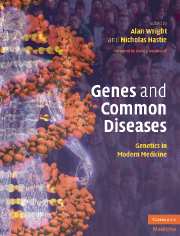Book contents
- Frontmatter
- Contents
- List of Contributors
- Foreword
- Section 1 Introductory Principles
- Section 2 Common Medical Disorders
- 13 Developmental disorders
- 14 Genes, environment and cancer
- 15 The polygenic basis of breast cancer
- 16 TP53: A master gene in normal and tumor suppression
- 17 Genetics of colorectal cancer
- 18 Genetics of autoimmune disease
- 19 Susceptibility to infectious diseases
- 20 Inflammatory bowel diseases
- 21 Genetic anemias
- 22 Genetics of chronic disease: obesity
- 23 Type 2 diabetes mellitus
- 24 Genetics of coronary heart disease
- 25 Genetics of hypertension
- 26 Obstructive pulmonary disease
- 27 Skeletal disorders
- 28 The genetics of common skin diseases
- 29 Molecular genetics of Alzheimer's disease and other adult-onset dementias
- 30 Major psychiatric disorders in adult life
- 31 Speech and language disorders
- 32 Common forms of visual handicap
- 33 Genetic and environmental influences on hearing impairment
- 34 Pharmacogenomics: clinical applications
- Index
- References
16 - TP53: A master gene in normal and tumor suppression
Published online by Cambridge University Press: 17 August 2009
- Frontmatter
- Contents
- List of Contributors
- Foreword
- Section 1 Introductory Principles
- Section 2 Common Medical Disorders
- 13 Developmental disorders
- 14 Genes, environment and cancer
- 15 The polygenic basis of breast cancer
- 16 TP53: A master gene in normal and tumor suppression
- 17 Genetics of colorectal cancer
- 18 Genetics of autoimmune disease
- 19 Susceptibility to infectious diseases
- 20 Inflammatory bowel diseases
- 21 Genetic anemias
- 22 Genetics of chronic disease: obesity
- 23 Type 2 diabetes mellitus
- 24 Genetics of coronary heart disease
- 25 Genetics of hypertension
- 26 Obstructive pulmonary disease
- 27 Skeletal disorders
- 28 The genetics of common skin diseases
- 29 Molecular genetics of Alzheimer's disease and other adult-onset dementias
- 30 Major psychiatric disorders in adult life
- 31 Speech and language disorders
- 32 Common forms of visual handicap
- 33 Genetic and environmental influences on hearing impairment
- 34 Pharmacogenomics: clinical applications
- Index
- References
Summary
Introduction
Since its discovery over 25 years ago, the TP53 gene is one of the “stars” of molecular cancer research. The p53 protein acts as an all-round regulator of many interconnected functions associated with cell cycle regulation, apoptosis, DNA repair, differentiation, senescence and development. Activation of p53 prevents DNA replication and cell proliferation when cells are subjected to stress that may perturb genetic or genomic integrity. Thus, TP53 acts as a “master suppressor gene” by exerting simultaneous, many-fingered control of several components of the molecular mechanisms of carcinogenesis. Mutations in TP53 result in loss of these suppressor functions. In some instances, it has been suggested that mutations may also exert gain-of-function effects that may explain the persistence of p53 mutant protein in cancer cells. TP53 is emerging as an important target for improving cancer detection, prognosis and treatment. However, forms of mutant p53 differ from each other and this may affect cancer development in an organ, tissue and context-specific manner. Addressing this diversity is essential for developing cancer management strategies using p53 as a target.
Cancer progression is characterized by acquisition of multiple genetic and epigenetic alterations in genes involved in interrelated processes controlling cell cycle, apoptosis, differentiation, replicative senescence, cell motility and migratory capacity (Hanahan and Weinberg, 2000). There are many ways in which cells develop defects in these processes, often in a cell-type, tissue- and context-specific manner. However, a small number of genes are commonly altered in many different cancers, irrespective of their histology or site.
- Type
- Chapter
- Information
- Genes and Common DiseasesGenetics in Modern Medicine, pp. 233 - 244Publisher: Cambridge University PressPrint publication year: 2007



